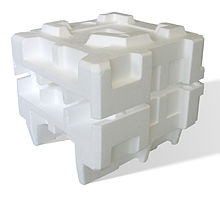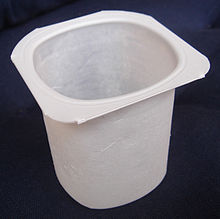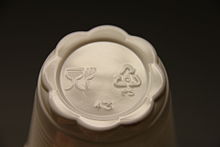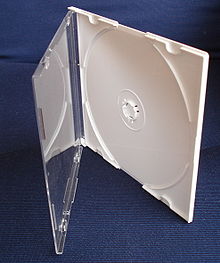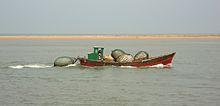
Polystyrene
Background Information
SOS Children, an education charity, organised this selection. SOS Children is the world's largest charity giving orphaned and abandoned children the chance of family life.
| Polystyrene | |
|---|---|
 |
|
|
Poly(1-phenylethane-1,2-diyl) |
|
|
Other names
Thermocole |
|
| Identifiers | |
| Abbreviations | PS |
| Properties | |
| Molecular formula | (C8H8)n |
| Density | 0.96-1.04 |
| Melting point |
~240 °C (decomposes at lower T) |
| Thermal conductivity | 0.033 W/(m·K) (foam, ρ 0.05 g/cm3) |
| Refractive index (nD) | 1.6; dielectric constant 2.6 (1 KHz – 1 GHz) |
| Related compounds | |
| Related compounds | Styrene (monomer) |
| Except where noted otherwise, data are given for materials in their standard state (at 25 °C, 100 kPa) | |
| Infobox references | |
Polystyrene (PS) (pron.: / ˌ p ɒ l i ˈ s t aɪ r iː n /) is a synthetic aromatic polymer made from the monomer styrene, a liquid petrochemical. Polystyrene can be rigid or foamed. General purpose polystyrene is clear, hard and brittle. It is a very inexpensive resin per unit weight. It is a rather poor barrier to oxygen and water vapor and has relatively low melting point. Polystyrene is one of the most widely used plastics, the scale of its production being several billion kilograms per year. Polystyrene can be naturally transparent, but can be colored with colorants. Uses include protective packaging (such as packing peanuts and CD and DVD cases), containers (such as "clamshells"), lids, bottles, trays, tumblers, and disposable cutlery.
As a thermoplastic polymer, polystyrene is in a solid (glassy) state at room temperature but flows if heated above about 100 °C, its glass transition temperature. It becomes rigid again when cooled. This temperature behaviour is exploited for molding and extrusion, since it can be cast into molds with fine detail.
It is very slow to biodegrade and therefore a focus of controversy, since it is often abundant as a form of litter in the outdoor environment, particularly along shores and waterways especially in its foam form.
History
Polystyrene was discovered in 1839 by Eduard Simon, an apothecary in Berlin. From storax, the resin of the Turkish sweetgum tree Liquidambar orientalis, he distilled an oily substance, a monomer that he named styrol. Several days later, Simon found that the styrol had thickened, presumably from oxidation, into a jelly he dubbed styrol oxide ("Styroloxyd"). By 1845 English chemist John Blyth and German chemist August Wilhelm von Hofmann showed that the same transformation of styrol took place in the absence of oxygen. They called their substance metastyrol. Analysis later showed that it was chemically identical to Styroloxyd. In 1866 Marcelin Berthelot correctly identified the formation of metastyrol/Styroloxyd from styrol as a polymerization process. About 80 years later it was realized that heating of styrol starts a chain reaction that produces macromolecules, following the thesis of German organic chemist Hermann Staudinger (1881–1965). This eventually led to the substance receiving its present name, polystyrene.
The company I. G. Farben began manufacturing polystyrene in Ludwigshafen, about 1931, hoping it would be a suitable replacement for die-cast zinc in many applications. Success was achieved when they developed a reactor vessel that extruded polystyrene through a heated tube and cutter, producing polystyrene in pellet form.
In 1941, Dow Chemical invented a Styrofoam process.
Before 1949, the chemical engineer Fritz Stastny (1908–1985) developed pre-expanded PS beads by incorporating aliphatic hydrocarbons, such as pentane. These beads are the raw material for moulding parts or extruding sheets. BASF and Stastny applied for a patent that was issued in 1949. The moulding process was demonstrated at the Kunststoff Messe 1952 in Düsseldorf. Products were named Styropor.
The crystal structure of isotactic polystyrene was reported by Giulio Natta.
In 1954, the Koppers Company, Inc. in Pittsburgh, Pennsylvania, developed expanded polystyrene (EPS) foam.
In 1960, Dart Container, the largest manufacturer of foam cups, shipped their first order.
In 1988, the first U.S. ban of general polystyrene foam was enacted in Berkeley, California.
Structure
In chemical terms, polystyrene is a long chain hydrocarbon wherein alternating carbon centers are attached to phenyl groups (the name given to the aromatic ring benzene). Polystyrene's chemical formula is (C8H8)n; it contains the chemical elements carbon and hydrogen.
The material's properties are determined by short-range van der Waals attractions between polymers chains. Since the molecules are long hydrocarbon chains that consist of thousands of atoms, the total attractive force between the molecules is large. When heated (or deformed at a rapid rate, due to a combination of viscoelastic and thermal insulation properties), the chains are able to take on a higher degree of conformation and slide past each other. This intermolecular weakness (versus the high intramolecular strength due to the hydrocarbon backbone) confers flexibility and elasticity. The ability of the system to be readily deformed above its glass transition temperature allows polystyrene (and thermoplastic polymers in general) to be readily softened and molded upon heating.
Extruded polystyrene is about as strong as an unalloyed aluminium, but much more flexible and much lighter (1.05 g/cm3 vs. 2.70 g/cm3 for aluminium).
Polymerization
Polystyrene results when styrene monomers interconnect. In the polymerization, the carbon-carbon pi bond (in the vinyl group) is broken and a new carbon-carbon single (sigma) bond is formed, attaching another styrene monomer to the chain. The newly formed sigma bond is much stronger than the pi bond that was broken, thus it is very difficult to depolymerize polystyrene. About a few thousand monomers typically comprise a chain of polystyrene, giving a molecular weight of 100,000–400,000.
A 3-D model would show that each of the chiral backbone carbons lies at the centre of a tetrahedron, with its 4 bonds pointing toward the vertices. Consider that the -C-C- bonds rotated so that the backbone chain lies entirely in the plane of the diagram. From this flat schematic, it is not evident which of the phenyl (benzene) groups are angled outward from the plane of the diagram, and which ones are inward. The isomer where all of the phenyl groups are on the same side is called isotactic polystyrene, which is not produced commercially.

Atactic polystyrene
The only commercially important form of polystyrene is atactic, in which the phenyl groups are randomly distributed on both sides of the polymer chain. This random positioning prevents the chains from aligning with sufficient regularity to achieve any crystallinity. The plastic has a glass transition temperature Tg of ~90 °C. Polymerization is initiated with free radicals.
Syndiotactic polystyrene
Ziegler-Natta polymerization can produce an ordered syndiotactic polystyrene with the phenyl groups positioned on alternating sides of the hydrocarbon backbone. This form is highly crystalline with a Tm of 270 °C (518 °F). Such materials are not commercially produced because the polymerization is slow.
Degradation
Polystyrene is very chemically inert, being resistant to acids and bases. Because of its resilience and inertness, it is used to fabricate many objects of commerce. It is attacked by many organic solvents, which dissolve the polymer. Foamed polystyrene is used for packaging chemicals.
Like all organic compounds, polystyrene burns to give carbon dioxide and water vapor. Polystyrene, being an aromatic hydrocarbon, typically combusts incompletely as indicated by the sooty flame.
Biodegradation
Methanogenic consortia have been shown to degrade styrene as sole carbon source (Grbić-Galić et al. 1990). In this case styrene degraded to a range of organic intermediates and carbon dioxide. Taking the carbon dioxide figures as a representation of the amount of styrene that had completely degraded to gas as is of interest here, rates of styrene degradation ranged from 0.14 to 0.4 a -1. This is an order of magnitude faster than the most rapid rate of polystyrene degradation identified (Kaplan et al. 1979, Sielicki et al. 1978). It is consistent with the T2GGM polystyrene degradation model (Quintessa and Geofirma 2011b), which considers the rate-limiting step for polystyrene degradation to be the breakup of polystyrene, rather than the degradation of styrene.
Forms produced
| Properties | |
|---|---|
| Density of EPS | 16–640 kg/m3 |
| Young's modulus (E) | 3000–3600 MPa |
| Tensile strength (st) | 46–60 MPa |
| Elongation at break | 3–4% |
| Notch test | 2–5 kJ/m2 |
| Glass transition temperature | 100 °C |
| Vicat B | 90 °C |
| Linear expansion coefficient (a) | 8×10−5 /K |
| Specific heat (c) | 1.3 kJ/(kg·K) |
| Water absorption (ASTM) | 0.03–0.1 |
| Decomposition | X years, still decaying |
Polystyrene is commonly injection molded or extruded, while expanded polystyrene is either extruded or molded in a special process. Polystyrene copolymers are also produced; these contain one or more other monomers in addition to styrene. In recent years the expanded polystyrene composites with cellulose and starch have also been produced. Polystyrene is used in some polymer-bonded explosives (PBX).
Sheet or molded polystyrene
Polystyrene (PS) is used for producing disposable plastic cutlery and dinnerware, CD "jewel" cases, smoke detector housings, license plate frames, plastic model assembly kits, and many other objects where a rigid, economical plastic is desired. Production methods include thermoforming and injection molding.
Polystyrene Petri dishes and other laboratory containers such as test tubes and microplates play an important role in biomedical research and science. For these uses, articles are almost always made by injection molding, and often sterilized post-molding, either by irradiation or by treatment with ethylene oxide. Post-mold surface modification, usually with oxygen-rich plasmas, is often done to introduce polar groups. Much of modern biomedical research relies on the use of such products; they therefore play a critical role in pharmaceutical research.
Foams
Polystyrene foams are good thermal insulators and are therefore often used as building insulation materials, such as in insulating concrete forms and structural insulated panel building systems. Polystyrene incorporating graphite has superior insulation properties. They are also used for non-weight-bearing architectural structures (such as ornamental pillars). PS foams also exhibit good damping properties, therefore it is used widely in packaging.
Extruded closed-cell polystyrene foam is sold under the trademark Styrofoam by Dow Chemical Company. This term is often used informally in North America for other foamed polystyrene products.
Expanded polystyrene
Expanded polystyrene (EPS) is a rigid and tough, closed-cell foam. It is usually white and made of pre-expanded polystyrene beads. EPS is used for disposable trays, plates, bowls and cups; and for carry-out food packaging (including the hinged lid containers popularly know as "clam shells"). Other uses include molded sheets for building insulation and packing material ( "peanuts") for cushioning fragile items inside boxes. Sheets are commonly packaged as rigid panels (size 4 by 8 or 2 by 8 feet in the United States), which are also known as "bead-board".
Thermal conductivity is measured according to EN 12667. Typical values range from 0.032 to 0.038 W/(m·K) depending on the density of the EPS board. The value of 0.038 W/(m·K) was obtained at 15 kg/m3 while the value of 0.032 W/(m·K) was obtained at 40 kg/m3 according to the data sheet of K-710 from StyroChem Finland. Adding fillers (graphites, aluminium, or carbons) has recently allowed the thermal conductivity of EPS to reach around 0.030–0.034 (as low as 0.029) and as such has a grey/black colour which distinguishes it from standard EPS. Several EPS producers have produced a variety of these increased thermal resistance EPS usage for this product in the UK & EU.
Water vapor diffusion resistance (μ) of EPS is around 30–70.
ICC-ES (International Code Council Evaluation Service) requires EPS boards used in building construction meet ASTM C578 requirements. One of these requirements is that the oxygen index of EPS as measured by ASTM D2863 be greater than 24 volume %. Typical EPS has an oxygen index of around 18 volume %; thus, a flame retardant such as HBCD (hexabromocyclododecane), is added to styrene or polystyrene during the formation of EPS.
The boards containing HBCD when tested in a tunnel using test method UL 723 or ASTM E84 will have a flame spread index of less than 25 and a smoke-developed index of less than 450. ICC-ES requires the use of a 15-minute thermal barrier when EPS boards are used inside of a building.
According to EPS-IA ICF organization, the typical density of EPS used for insulated concrete forms is 1.35 to 1.80 pcf. This is either Type II or Type IX EPS according to ASTM C578. EPS blocks or boards used in building construction are commonly cut using hot wires.
Extruded polystyrene foam
Extruded polystyrene foam (XPS) consists of closed cells, offers improved surface roughness and higher stiffness and reduced thermal conductivity. The density range is about 28–45 kg/m3.
Extruded polystyrene material is also used in crafts and model building, in particular architectural models. Because of the extrusion manufacturing process, XPS does not require facers to maintain its thermal or physical property performance. Thus, it makes a more uniform substitute for corrugated cardboard. Thermal resistivity is usually about 35 m·K/W (or R-5 per inch in American customary units) but can range between 29 and 39 m·K/W depending on bearing/density. Thermal conductivity varies between 0.029 and 0.039 W/(m·K) depending on bearing strength/density and the average value is ~0.035 W/(m·K).
Water vapour diffusion resistance (μ) of XPS is around 80–250 and so makes it more suitable to wetter environments than EPS.
Copolymers
Pure polystyrene is brittle, but hard enough that a fairly high-performance product can be made by giving it some of the properties of a stretchier material, such as polybutadiene rubber. The two such materials can never normally be mixed because of the amplified effect of intermolecular forces on polymer insolubility (see plastic recycling), but if polybutadiene is added during polymerization it can become chemically bonded to the polystyrene, forming a graft copolymer, which helps to incorporate normal polybutadiene into the final mix, resulting in high-impact polystyrene or HIPS, often called "high-impact plastic" in advertisements. One commercial name for HIPS is Bextrene. Common applications of HIPS include toys and product casings. HIPS is usually injection molded in production. Autoclaving polystyrene can compress and harden the material.
Several other copolymers are also used with styrene. Acrylonitrile butadiene styrene or ABS plastic is similar to HIPS: a copolymer of acrylonitrile and styrene, toughened with polybutadiene. Most electronics cases are made of this form of polystyrene, as are many sewer pipes. SAN is a copolymer of styrene with acrylonitrile, and SMA one with maleic anhydride. Styrene can be copolymerized with other monomers; for example, divinylbenzene can be used for cross-linking the polystyrene chains to give the polymer used in Solid phase peptide synthesis.
Oriented polystyrene
Oriented polystyrene (OPS) is produced by stretching extruded PS film, improving visibility through the material by reducing haziness and increasing stiffness. This is often used in packaging where the manufacturer would like the consumer to see the enclosed product. Some benefits to OPS are that it is less expensive to produce than other clear plastics such as PP, PET, and HIPS, and it is less hazy than HIPS or PP. The main disadvantage to OPS is that it's brittle. It will crack or tear easily.
Environmental issues
Production
Polystyrene foams are produced using blowing agents that form bubbles and expand the foam. In expanded polystyrene, these are usually hydrocarbons such as pentane, which may pose a flammability hazard in manufacturing or storage of newly manufactured material, but have relatively mild environmental impact. Extruded polystyrene is usually made with hydrofluorocarbons ( HFC-134a), which have global warming potentials of approximately 1000–1300 times that of carbon dioxide.
Non-biodegradable
Discarded polystyrene does not biodegrade for hundreds of years and is resistant to photolysis.
Litter
Polystyrene foam is a major component of plastic debris in the ocean, where it becomes hazardous to marine life and "could lead to the transfer [of] toxic chemicals to the food chain". Animals do not recognize this artificial material and may even mistake it for food. Polystyrene foam blows in the wind and floats on water, and is abundant in the outdoor environment. It can be lethal to any bird or sea creature that swallows significant quantities.
Reducing
Restricting the use of foamed polystyrene takeout food packaging is a priority of many solid waste environmental organizations. Efforts have been made to find alternatives to polystyrene, especially foam in restaurant settings. The original impetus was to eliminate chlorofluorocarbons (CFC), which was former component of foam. In 1987, Berkeley banned CFC food containers. In 1988, Suffolk County, New York became the first U.S. locality to ban polystyrene. However, legal challenges by the Society of the Plastics Industry kept it from going into effect until at last it was delayed when the Republican and Conservative parties became a majority of the county legislature. In the meantime, Berkeley became the first city to ban all foam food containers. As of 2006, about one hundred localities in the United States including Portland, Oregon and San Francisco currently have some sort of ban on polystyrene foam in restaurants. For instance, in 2007 Oakland, California required restaurants to switch to disposable food containers that will biodegrade if added to food compost. Some communities have implemented wide polystyrene bans, such as Freeport, Maine, which did so in 1990.
The U.S. Green Restaurant Association does not allow polystyrene foam to be used as part of their certification standard. Several green leaders, from the Dutch Ministry of the Environment to Starbucks' Green Team, advise that individuals reduce their environmental impact by using reusable coffee cups.
Recycling
In general, polystyrene is not accepted in curbside collection recycling programs, and is not separated and recycled where it is accepted. In Germany, polystyrene is collected, as a consequence of the packaging law (Verpackungsverordnung) that requires manufacturers to take responsibility for recycling or disposing of any packaging material they sell.
Most polystyrene products are currently not recycled due to the lack of incentive to invest in the compactors and logistical systems required. Due to the low density of polystyrene foam, it is not economical to collect. However, if the waste material goes through an initial compaction process, the material changes density from typically 30 kg/m3 to 330 kg/m3 and becomes a recyclable commodity of high value for producers of recycled plastic pellets. Expanded polystyrene scrap can be easily added to products such as EPS insulation sheets and other EPS materials for construction applications; many manufacturers cannot obtain sufficient scrap because of collection issues. When it is not used to make more EPS, foam scrap can be turned into clothes hangers, park benches, flower pots, toys, rulers, stapler bodies, seedling containers, picture frames, and architectural molding from recycled PS.
Recycled EPS is also used in many metal casting operations. Rastra is made from EPS that is combined with cement to be used as an insulating amendment in the making of concrete foundations and walls. American manufacturers have produced insulating concrete forms made with approximately 80% recycled EPS since 1993.
Incineration
If polystyrene is properly incinerated at high temperatures, the chemicals generated are water, carbon dioxide, a complex mixture of volatile compounds, and carbon soot. According to the American Chemistry Council, when polystyrene is incinerated in modern facilities, the final volume is 1% of the starting volume; most of the polystyrene is converted into carbon dioxide, water vapor, and heat. Because of the amount of heat released, it is sometimes used as a power source for steam or electricity generation.
When polystyrene was burned at temperatures of 800–900 °C (the typical range of a modern incinerator), the products of combustion consisted of "a complex mixture of polycyclic aromatic hydrocarbons (PAHs) from alkyl benzenes to benzoperylene. Over 90 different compounds were identified in combustion effluents from polystyrene."
Safety
Health
According to a plastic food service products website of the American Chemistry Council:
Based on scientific tests over five decades, government safety agencies have determined that polystyrene is safe for use in foodservice products. For example, polystyrene meets the standards of the U.S. Food and Drug Administration and the European Commission/European Food Safety Authority for use in packaging to store and serve food. The Hong Kong Food and Environmental Hygiene Department recently reviewed the safety of serving various foods in polystyrene foodservice products and reached the same conclusion as the U.S. FDA.
From 1999 to 2002, a comprehensive review of the potential health risks associated with exposure to styrene was conducted by a 12 member international expert panel selected by the Harvard Centre for Risk Assessment. The scientists had expertise in toxicology, epidemiology, medicine, risk analysis, pharmacokinetics, and exposure assessment.
The Harvard study reported that styrene is naturally present in foods such as strawberries, beef, and spices, and is naturally produced in the processing of foods such as wine and cheese. The study also reviewed all the published data on the quantity of styrene contributing to the diet due to migration of food packaging and disposable food contact articles, and concluded there is no cause for concern for the general public from exposure to styrene from foods or styrenic materials used in food-contact applications, such as polystyrene packaging and food service containers.
Polystyrene is common container for food and drinks. The styrene monomer (from which polystyrene is made) is a cancer suspect agent; it is "generally found in such low levels in consumer products that risks are low".
Styrene in food or water can rapidly enter the body through the digestive tract and most of these chemicals are excreted in urine within a few days. Styrene is highly metabolized in humans, with an estimated 97% eliminated through metabolic pathways.
Because of the pervasive use of polystyrene, these health related issues remain topical.
Styrene oligomers in polystyrene containers used for food packaging have been found to migrate into the food. Another Japanese study conducted on wild-type and AhR-null mice found that the styrene trimer, which the authors detected in cooked polystyrene container-packed instant foods, may increase thyroid hormone levels.
Some containers may be safely used in a microwave, if labelled as such.
Fire hazards
Like other organic compounds, polystyrene is flammable. Polystyrene is classified according to DIN4102 as a "B3" product, meaning highly flammable or "Easily Ignited." As a consequence, although it is an efficient insulator at low temperatures, its use is prohibited in any exposed installations in building construction if the material is not flame-retardant. It must be concealed behind drywall, sheet metal, or concrete. Foamed polystyrene plastic materials have been accidentally ignited and caused huge fires and losses, for example at the Düsseldorf International Airport, the Channel tunnel (where polystyrene was inside a railcar that caught fire), and the Browns Ferry Nuclear Power Plant (where fire breached a fire retardant and reached the foamed plastic underneath, inside a firestop that had not been tested and certified in accordance with the final installation).
